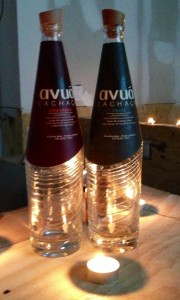Say Olá to Avuá Cachaça!
Outside of its native Brazil, cachaça is one of the most misunderstood of spirits. For years, because it is sugarcane-based, it’s been lumped unceremoniously in the rum category. Some people even refer to it as “that Brazilian rum.” But it’s not a rum, it’s cachaça, which really isn’t like rum at all, but a very distant cousin. Only recently was it even recognized in the US as its own distinct category.
Then there’s the problem of pronouncing it. The “ç” sets minds a-fluster, even though it’s just a different way of uttering a hard “s” sound. Say it now: “Ka-sha-sa,” emphasis on the second syllable.
Ok, now you can say it, but how do you drink it? Most of us who haven’t been lucky enough to enjoy a true Rio sunset on the beach only know one type of cachaça (silver - prata, clear and unaged.) What we get here has usually been rough and mass-produced, with only one known use for it - the classic caipirinha cocktail - cachaça with muddled lime and sugar. The Brazilian Old Fashioned.
Now that cachaça is growing steadily as its own category in the US, and with Rio hosting both the 2014 World Cup, and the 2016 Summer Olympic Games, it’s time we all got to know it better.
Enter Avuá cachaça. To put it into spirits terms most of us understand, think of Avuá (again emphasizing the second syllable - “Ah-vwah”) as a “single malt cachaça.” It is produced from sugarcane grown in a single farm estate (fazenda) outside of Rio, which is dedicated to sustainable energy practices, then distilled in an ancient alembic still in Carmo. Even more remarkable, it is a family-run business owned and operated by one of the country’s few female distillers.
The fazenda where the cane is grown was founded by her grandfather, then eventually taken over by his son. Traditionally, family cachaça production is passed on between males, but in this case the reins were passed between father and daughter when the time came. This is pretty much unheard of in an industry dominated by men.
Avuá came to us over the course of three years, by way of three friends - Nate Whitehouse, Peter Nevenglosky and Mark Christou - who experienced a life-changing introduction to rare cachaça and its celebratory culture, by way of a cafe in Williamsburg, of all places. After tasting some rare cachaças that day and going back for more on others, a deep passion for the spirit developed within them. It inspired them to embark on a quest to find the right one to introduce in the US - one that would truly evoke the spirit’s inherent, sippable characteristics and cultural significance. One that would ensure a wider consumer base finally “gets” cachaça. Well, they eventually found it, and for that we owe them a major obrigado.
Avuá is available in two versions:
Prata is the silver, though even this one has aged 12 months before bottling. This produces a much smoother, more complex cachaça than most of us are used to. It’s fruity (pear, grapes, white peach) with notes of white flowers in the finish.
Amburana is aged for 24 months in Amburana wood, native only to Brazil and South America. Most of us haven’t tried aged cachaça, so there is nothing to compare it to in its category. Instead of the oak flavors we know from bourbon, Scotch, rum or Cognac, the wood imparts more sweet/savory herbal characteristics, such as thyme or basil. But like other oak finishes and because of the heat of its environment, the wood also lends rich flavors of vanilla and caramel to the mix. Great sipped neat as intended, but it also works wonders in cocktails, especially stirred ones.
Both expressions are excellent bases for the traditional caipirinha but several bartenders have come up with other ways to show them off in cocktails.
The Creole Caipirinha
by Damon Dyer
2 oz Avuá Prata
3/4 lime sectioned
barspoon cane sugar
1/4 oz Allspice Dram
dash Angostura bitters
muddled and served on the rocks
A Lorena
by Michael Neff, Ward III and Rum House
2 oz Avuá Prata
3/4 oz Triple Sec
3/4 oz fresh lime juice
muddled Malaguetta peppers (or jalapeños)
smoked salt rim
all ingredients shaken, strained and served up
Oscar Ribeiro Neimayer
by Cervantes Ramirez, Little Branch
2 oz Avuá Amburana
1 oz Amaro
1 oz Orgeat syrup
stirred, served up with lemon peel
Pan Am
by Luis Gil, Little Branch
2 oz Avuá Amburana
1 oz Curaçao
1 oz dry Vermouth
couple dashes orange bitters
Stirred, served up with an orange twist





